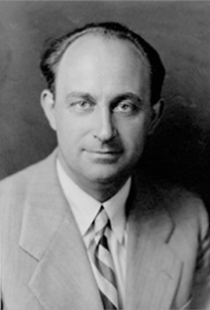
Enrico Fermi, phsyicist
Enrico Fermi, 1901 – 1954, is often described as a complete physicist because he understood and could expound upon of all of physics at the time. Richard Rhodes called him “the last of the double-threat physicists: genius at creating both esoteric theories and elegant experiments.”
For a lot of scientists, one of the appealing things about my grandfather was his wide-ranging interests. He looked for simplicity and elegance wherever it could be found. Scientists I’ve met along the Neutron Trail and physicists who knew him personally have explained to me he is known for contributions to relativity, statistical physics, quantum mechanics, computational physics, and — of course — particle physics (but not just neutrons, also weak interactions and other things). At Chicago, he would quiz doctoral candidates, asking them to estimate almost any kind of number, from the cross section of the neutron to the number of piano tuners in the New York City. He truly had catholic (small c) tastes!
In 1952, Enrico pondered the dilemma which has come to symbolize his legacy in a socio-political context:
“Some of you may ask, what is the good of working so hard merely to collect a few facts which will bring no pleasure except to a few long-haired professors who love to collect such things and will be of no use to anybody because only few specialists at best will be able to understand them? In answer to such question[s] I may venture a fairly safe prediction.
“History of science and technology has consistently taught us that scientific advances in basic understanding have sooner or later led to technical and industrial applications that have revolutionized our way of life. It seems to me improbable that this effort to get at the structure of matter should be an exception to this rule. What is less certain, and what we all fervently hope, is that man will soon grow sufficiently adult to make good use of the powers that he acquires over nature.”
— Enrico Fermi, Enrico Fermi Collection, [Box 53, Folder 12], Special Collections Research Center, University of Chicago Library; notes for a lecture on “The Future of Nuclear Physics” for the American Physical Society meeting in Rochester, NY, January 10, 1952
Spanish Translation of this web page by Jose Bescos at https://www.ibidemgroup.com/. Macedonian translation of this web page by Alexander Ovsov, Web Geek Science, via Translation for Education.



